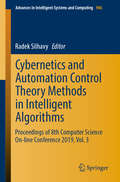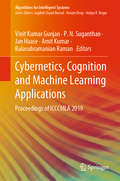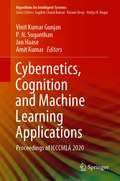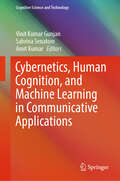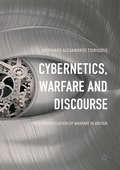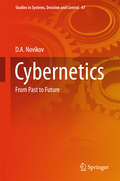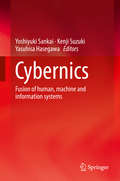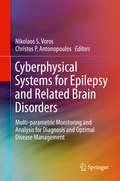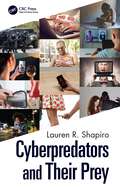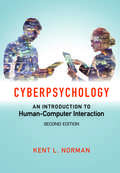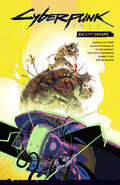- Table View
- List View
Cybernetics and Applied Systems
by Constantin Virgil NegoitaIn light of the enormous interest in building intelligent systems, this volume blends theory, applications, and methodology of cybernetics taking it out of the realm of the abstract and explaining how cybernetics can contribute to an improved understanding of intelligence. Among the topics of the 17
Cybernetics and Automation Control Theory Methods in Intelligent Algorithms: Proceedings of 8th Computer Science On-line Conference 2019, Vol. 3 (Advances in Intelligent Systems and Computing #986)
by Radek SilhavyThis book discusses novel intelligent-system algorithms and methods in cybernetics, presenting new approaches in the field of cybernetics and automation control theory. It constitutes the proceedings of the Cybernetics and Automation Control Theory Methods in Intelligent Algorithms Section of the 8th Computer Science On-line Conference 2019 (CSOC 2019), held on-line in April 2019.
Cybernetics and Control Theory in Systems: Proceedings of 13th Computer Science On-line Conference 2024, Volume 2 (Lecture Notes in Networks and Systems #1119)
by Radek Silhavy Petr SilhavyAddressing key issues in modern cybernetics and informatics, this book presents vital research within networks and systems. It offers an extensive overview of the latest methods, algorithms, and design innovations. This book compiles the meticulously reviewed proceedings of the Networks and Systems in Cybernetics session of the 13th Computer Science Online Conference 2024 (CSOC 2024), held virtually in April 2024.
Cybernetics and Mathematics Applications in Intelligent Systems: Proceedings of the 6th Computer Science On-line Conference 2017 (CSOC2017), Vol 2 (Advances in Intelligent Systems and Computing #574)
by Radek Silhavy Roman Senkerik Zuzana Kominkova Oplatkova Petr Silhavy Zdenka ProkopovaThis book presents new methods for and approaches to real-world problems as well as exploratory research describing novel mathematics and cybernetics applications in intelligent systems. It focuses on modern trends in selected fields of technological systems and automation control theory. It also introduces new algorithms, methods and applications of intelligent systems in automation, technological and industrial applications. This book constitutes the refereed proceedings of the Cybernetics and Mathematics Applications in Intelligent Systems Section of the 6th Computer Science On-line Conference 2017 (CSOC 2017), held in April 2017.
Cybernetics and Systems: Social and Business Decisions (Routledge-Giappichelli Systems Management)
by Raul Espejo Sergio Barile Igor Perko Marialuisa SavianoSociety is now facing challenges for which the traditional management toolbox is increasingly inadequate. Well-grounded theoretical frameworks, such as systems thinking and cybernetics, offer general level interpretation schemes and models that are capable of supporting understanding of complex phenomena and are not impacted by the passage of time. This book serves the knowledge society to address the complexity of decision making and problem solving in the 21st century with contributions from systems and cybernetics. A multi-disciplinary approach has been adopted to support diversity and to develop inter- and trans-disciplinary knowledge within the shared thematic of problem solving and decision making in the 21st century. Its conceptual thread is cyber/systemic thinking, and its realisation is supported by a wide network of scientists on the basis of a highly participative agenda. The book provides a platform of knowledge sharing and conceptual frameworks developed with multi-disciplinary perspectives, which are useful to better understand the fast changing scenario and the complexity of problem solving in the present time.
Cybernetics and the Constructed Environment: Design Between Nature and Technology
by Zihao ZhangGrounded in contemporary landscape architecture theory and practice, Cybernetics and the Constructed Environment blends examples from art, design, and engineering with concepts from cybernetics and posthumanism, offering a transdisciplinary examination of the ramifications of cybernetics on the constructed environment. Cybernetics, or the study of communication and control in animals and machines, has grown increasingly relevant nearly 80 years after its inception. Cyber-physical systems, sensing networks, and spatial computing—algorithms and intelligent machines—create endless feedback loops with human and non-human actors, co-producing a cybernetic environment. Yet, when an ecosystem is meticulously managed by intelligent machines, can we still call it wild nature? Posthumanism ideas, such as new materialism, actor-network theory, and object-oriented ontology, have become increasingly popular among design disciplines, including landscape architecture, and may have provided transformative frameworks to understand this entangled reality. However, design still entails a sense of intentionality and an urge to control. How do we, then, address the tension between the designer’s intentionality and the co-produced reality of more-than-human agents in the cybernetic environment? Is posthumanism enough to develop a framework to think beyond our all-too-human ways of thinking? For researchers, scholars, practitioners, and students in environmental design and engineering disciplines, this book maps out a paradigm of environmentalism and ecological design rooted in non-communication and uncontrollability, and puts a speculative turn on cybernetics.Chapters 8 and 9 of this book are freely available as a downloadable Open Access PDF at http://www.taylorfrancis.com under a Creative Commons Attribution-Non Commercial-No Derivatives (CC-BY-NC-ND) 4.0 license.
Cybernetics in C++ (River Publishers Series In Software Engineering Ser.)
by Avi BhattacharyyaC++ is a powerful, much sought after programming language, but can be daunting to work with, even for engineering professionals. Why is this book so useful? Have you ever wondered:- How do keywords like static and virtual change their meanings according to context?- What are the similarities and differences between Pointers and References, Pointers and Arrays, Constructors and Copy Constructors, Nested and Local Inner Classes?- Why is Multiple Interface Inheritance seen to be beautiful but Multiple Implementation Inheritance considered evil?- When is Polymorphism Static or Dynamic, Bounded or Unbounded?Answers on these questions, and much more, are explained in this book, Cybernetics in C++. What makes this text so different and appealing in comparison to existing books on the market?- The Bulleted style, as opposed to Prose, produces results much faster, both in learning and reference- Rules of Thumb, and further expert Tips are given throughout in how to optimise your code- The Prospective Evils sections tell you what to avoid- The thorough coverage ensures you will be trained to expert level in each of Imperative, Procedural, Memory & Resource Management, Object Oriented and Generic ProgrammingCybernetics in C++ combines a theoretical overview and practical approach in one book, which should prove to be a useful reference for computer scientists, software programmers, engineers and students in this and related field.
Cybernetics of Art: Reason and the Rainbow (Routledge Revivals)
by M. J. RosenbergFirst published in 1983, Cybernetics of Art uses the methodology and concepts of cybernetics to explore art and the creative process. Part I surveys the domain that includes both science and the arts, attempting to understand their differing viewpoints- and the basis of conflicts between them. Art is approached as a method of knowledge aimed at knowledge of experience per se (as distinct from knowledge derived through experience).Part II poses the problem of notionally constructing an authorship machine and develops the technical argument by exploring the question of the kind of machine it would need to be. Part III examines the products of such a machine with a view to finding criteria for distinguishing those that might be called art. An extended, non-technical commentary accompanies the text throughout, with the dual aim of comparing the book’s technical conclusions with ideas expressed by critiques and practicing artists and assisting readers unfamiliar with the information sciences in following the argument. In a world dominated by artificial intelligence, this interdisciplinary book will be useful for scholars and researchers of cybernetics, art, and humanities and social sciences in general.
Cybernetics or Control and Communication in the Animal and the Machine, Reissue of the 1961 second edition: Or Control And Communication In The Animal And The Machine (The\mit Press Ser.)
by Norbert WienerA classic and influential work that laid the theoretical foundations for information theory and a timely text for contemporary informations theorists and practitioners.With the influential book Cybernetics, first published in 1948, Norbert Wiener laid the theoretical foundations for the multidisciplinary field of cybernetics, the study of controlling the flow of information in systems with feedback loops, be they biological, mechanical, cognitive, or social. At the core of Wiener's theory is the message (information), sent and responded to (feedback); the functionality of a machine, organism, or society depends on the quality of messages. Information corrupted by noise prevents homeostasis, or equilibrium. And yet Cybernetics is as philosophical as it is technical, with the first chapter devoted to Newtonian and Bergsonian time and the philosophical mixed with the technical throughout. This book brings the 1961 second edition back into print, with new forewords by Doug Hill and Sanjoy Mitter. Contemporary readers of Cybernetics will marvel at Wiener's prescience—his warnings against “noise,” his disdain for “hucksters” and “gadget worshipers,” and his view of the mass media as the single greatest anti-homeostatic force in society. This edition of Cybernetics gives a new generation access to a classic text.
Cybernetics, Cognition and Machine Learning Applications: Proceedings of ICCCMLA 2019 (Algorithms for Intelligent Systems)
by Amit Kumar Vinit Kumar Gunjan Jan Haase Balasubramanian Raman P. N. SuganthanThis book provides a collection of selected papers presented at the International Conference on Cybernetics, Cognition and Machine Learning Applications (ICCCMLA 2019), which was held in Goa, India, on 16–17 August 2019. It covers the latest research trends and advances in the areas of data science, artificial intelligence, neural networks, cognitive science and machine learning applications, cyber-physical systems, and cybernetics.
Cybernetics, Cognition and Machine Learning Applications: Proceedings of ICCCMLA 2020 (Algorithms for Intelligent Systems)
by Amit Kumar Vinit Kumar Gunjan Jan Haase P. N. SuganthanThis book includes the original, peer reviewed research articles from the 2nd International Conference on Cybernetics, Cognition and Machine Learning Applications (ICCCMLA 2020), held in August, 2020 at Goa, India. It covers the latest research trends or developments in areas of data science, artificial intelligence, neural networks, cognitive science and machine learning applications, cyber physical systems and cybernetics.
Cybernetics, Cognition and Machine Learning Applications: Proceedings of ICCCMLA 2021 (Algorithms for Intelligent Systems)
by Amit Kumar Vinit Kumar Gunjan Jan Haase P. N. SuganthanThis book includes the original, peer-reviewed research articles from the 3rd International Conference on Cybernetics, Cognition and Machine Learning Applications (ICCCMLA 2021), held in August 21 – 22, 2021, at Goa, India. It covers the latest research trends or developments in areas of data science, artificial intelligence, neural networks, cognitive science and machine learning applications, cyber physical systems and cybernetics.
Cybernetics, Human Cognition, and Machine Learning in Communicative Applications (Cognitive Science and Technology)
by Amit Kumar Vinit Kumar Gunjan Sabrina SenatoreThis book presents the fascinating intersection of human cognition and artificial intelligence. Written by leading experts in the fields of cybernetics, cognitive science, and machine learning, this book seeks to bridge the gap between these disciplines and explores the synergies that emerge when humans and machines work together. The book examines the challenges posed by biased data, lack of transparency, and the "black box" nature of some machine learning algorithms. It proposes novel ways to address these issues and foster greater trust and accountability in AI systems. Drawing on cutting-edge research and real-world case studies, it presents a comprehensive and forward-looking perspective on the future of AI and its impact on society. In conclusion, this book offers a compelling exploration of the synergy between human cognition and machine learning, providing insights that are relevant to scholars, researchers, policymakers, and anyone interested in the transformative potential of artificial intelligence.
Cybernetics, Warfare and Discourse: The Cybernetisation of Warfare in Britain
by Anthimos Alexandros TsirigotisThis book critiques mainstream beliefs about cyberwarfare and forges a new path in the way of defining this largely misunderstood concept. Rather than outlining cyberspace as a new technology applied in military operations, here, Tsirigotis rallies against this technocentric account and establishes how cyberspace, first and foremost, should be categorized as a new way to understand war and military power in the Information Age. Using genre analysis and Corpus Linguistics, the author scrutinizes how cyberspace has changed the way the UK comprehends war and military power, and how the cybernetisation of war has manifested itself in Britain's approach to national defense and security.
Cybernetics: From Past to Future (Studies in Systems, Decision and Control #47)
by D. A. NovikovThis book is a concise navigator across the history of cybernetics, itsstate-of-the-art and prospects. The evolution of cybernetics (from N. Wiener tothe present day) and the reasons of its ups and downs are presented. Thecorrelation of cybernetics with the philosophy and methodology of control, aswell as with system theory and systems analysis is clearly demonstrated. The book presents a detailed analysis focusing on the modern trends ofresearch in cybernetics. A new development stage of cybernetics (the so-calledcybernetics 2. 0) is discussed as a science on general regularities of systemsorganization and control. The author substantiates the topicality ofelaborating a new branch of cybernetics, i. e. organization theory which studiesan organization as a property, process and system. The book is intended for theoreticians andpractitioners, as well as for students, postgraduates and doctoral candidates. In the first place, the target audience includes tutors and lecturers preparingcourses on cybernetics, control theory and systems science.
Cybernics: Fusion of human, machine and information systems
by Yoshiyuki Sankai Kenji Suzuki Yasuhisa HasegawaCybernics plays a significant role in coping with an aging society using state-of-the-art technologies from engineering, clinical medicine and humanities. This new interdisciplinary field studies technologies that enhance, strengthen, and support physical and cognitive functions of human beings, based on the fusion of human, machine, and information systems. The design of a seamless interface for interaction between the interior and exterior of the human body is described in this book from diverse aspects such as the physical, neurophysiological, and cognitive levels. It is the first book to cover the many aspects of cybernics, allowing readers to understand the life support robotics technology for the elderly, including remote, in-home, hospital, institutional, community medical welfare, and vital-sensing systems. Serving as a valuable resource, this volume will interest not only graduate students, scientists, and engineers but also newcomers to the field of cybernics.
Cyberology: An Optimized Approach to the Cyber-World
by Mohammad Faisal Saurabh Shukla Mohd. Shahid Husain Halima Sadia Tasneem Ahmed Adil KaleemThis book provides an insightful examination of cybersecurity threats and their implications across various sectors, including healthcare, agriculture, and government. It covers fundamental concepts in cybersecurity, including cybercrime laws, cyberbullying and emerging technologies. It discusses challenges in detecting and preventing cyber threats and analyzes trends in cyber warfare and resilience. This book serves as a resource for understanding the complex relationship between technology and society, equipping readers with the knowledge needed to navigate the evolving cyber landscape. It is for scholars, students, and professionals interested in cybersecurity and challenges. This book introduces the fundamental principles and theories of cybersecurity, focusing on the relationship between humans and technology details various cyber threats affecting the digital world, healthcare, and agriculture, emphasizing their real-world implications discusses issues like cyberbullying, threats in cloud computing, and vulnerabilities in cyber-physical systems examines the difficulties in detecting cybercrimes, addressing advanced persistent threats, and fostering cyber resilience analyzes current trends in cyber warfare and terrorism, providing insights into new security challenges
Cyberpatterns: Unifying Design Patterns with Security and Attack Patterns
by Clive Blackwell Hong ZhuCyberspace in increasingly important to people in their everyday lives for purchasing goods on the Internet, to energy supply increasingly managed remotely using Internet protocols. Unfortunately, this dependence makes us susceptible to attacks from nation states, terrorists, criminals and hactivists. Therefore, we need a better understanding of cyberspace, for which patterns, which are predictable regularities, may help to detect, understand and respond to incidents better. The inspiration for the workshop came from the existing work on formalising design patterns applied to cybersecurity, but we also need to understand the many other types of patterns that arise in cyberspace.
Cyberphysical Systems for Epilepsy and Related Brain Disorders: Multi-parametric Monitoring and Analysis for Diagnosis and Optimal Disease Management
by Nikolaos S. Voros Christos P. AntonopoulosThis book introduces a new cyberphysical system that combines clinical and basic neuroscience research with advanced data analysis and medical management tools for developing novel applications for the management of epilepsy. The authors describe the algorithms and architectures needed to provide ambulatory, diagnostic and long-term monitoring services, through multi parametric data collection. Readers will see how to achieve in-hospital quality standards, addressing conventional "routine" clinic-based service purposes, at reduced cost, enhanced capability and increased geographical availability. The cyberphysical system described in this book is flexible, can be optimized for each patient and is demonstrated in several case studies.
Cyberpredators and Their Prey
by Lauren R. ShapiroThe online environment has emerged as a continuous and unfettered source of interpersonal criminal activity beyond physical boundaries. Cyberpredators commit their crimes by employing the Internet and online services—social network platforms, online groups and organizations, smart phone apps, bulletin board systems, online forums, websites, internet relay chat channels—to locate and harm victims of all ages through attacking, exploiting, humiliating, bullying, harassing, threatening, defrauding, and exhorting. Cyberpredators and Their Prey describes non-sexual and sexual interpersonal crimes—online romance scam, swatting, trolling, stalking, bullying, harassment, minor sexting, sexual trafficking, child sexual abuse material, sextortion, and image-based sexual abuse offenses. Each chapter contains: crime definition and relevant issues; typical cyberpredator, motives, and methods; typical victims and behaviors that make them targets; current criminal laws for prosecuting cybercrimes and assessment of their applicability and effectiveness as deterrents; the crime’s impact on individual victims and society in general; and cybersecurity prevention and intervention strategies. Also covered are the unique challenges that the regulation, investigation, and prosecution of these cybercrimes pose to criminal justice and private security agents worldwide; the need for society to hold companies operating online responsible for their role in cybercrime; and how aspects of the online environment (i.e., anonymity, toxic disinhibition, de-individuation, inculpability) contribute to harmful and abusive interpersonal interaction, particularly when enacted by perpetrators as part of a group attack. Key features: Portrays material through multidisciplinary lens of psychology, criminal justice, law, and security Provides consistent, practical information about online criminals and victims Compares online to offline versions of the same crime Discusses adequacy of current laws for prosecuting cybercriminals Considers elements of the online environment that foster criminal activity Describes social engineering techniques Considers the role of intimate partner violence in cybercrimes Reviews 21st century skills needed to educate and protect potential targets Cyberpredators and Their Prey will prove essential reading to those who are studying to become, or are currently, security professionals; law enforcement personnel and investigators; intelligence agents; private investigators; lawyers; compliance officers; social service workers; and other professionals who deal with interpersonal cybercrime through the lens of social science.
Cyberprotest: New Media, Citizens and Social Movements
by Dieter Rucht Brian D. Loader Paul G. Nixon Wim Van De DonkEver since the anti-globalisation protests in Seattle in 1999 the adoption of new information and communications technologies (ICTs) by social movement activists has offered the prospect for the development of global cyberprotest. The Internet with its transnational many-to-many communication facility offers a revolutionary potential for social movements to go online and circumvent the 'official' messages of political and commercial organisations and the traditional media, by speaking directly to the citizens of the world. Furthermore the use of electronic mail (e-mail), mailing lists, websites, electronic forums and other online applications provide powerful media tools for co-ordinating the activity of often physically dispersed movement actors. Moreover, ICTs may also contribute to the important function of social movements of shaping collective identity and countering the claims and arguments of established political interests. A growing body of literature during the last decades of the twentieth century attests to the significant impact SMs have had upon the restructuring of the political landscape. Most of that literature addresses the more traditional actors and institutions (e.g. parliaments, political parties, bureaucracy etc.). Less attention has been devoted to those manifestations of political action that are concentrated around social movements and all kinds of more or less institutionalised and sustainable forms of citizen mobilisation. This book is a collection of cases that take a critical look into the way ICTs are finding their way into the world of social movements
Cyberpsychology as Everyday Digital Experience across the Lifespan: Everyday Digital Experience Across The Lifespan
by Hannah Frith Dave Harley Julie MorganDigital technologies are deeply embedded in everyday life with opportunities for information access and perpetual social contact now mediating most of our activities and relationships. This book expands the lens of Cyberpsychology to consider how digital experiences play out across the various stages of people’s lives. Most psychological research has focused on whether human-technology interactions are a ‘good’ or a ‘bad’ thing for humanity. This book offers a distinctive approach to the emergent area of Cyberpsychology, moving beyond these binary dilemmas and considering how popular technologies have come to frame human experience and relationships. In particular the authors explore the role of significant life stages in defining the evolving purpose of digital technologies. They discuss how people’s symbiotic relationship with digital technologies has started to redefine our childhoods, how we experience ourselves, how we make friends, our experience of being alone, how we have sex and form romantic relationships, our capacity for being antisocial as well as the experience of growing older and dying. This interdisciplinary book will be of great interest to scholars and practitioners across psychology, digital technology and media studies as well as anyone interested in how technology influences our behaviour.
Cyberpsychology: An Introduction to Human–Computer Interaction
by Norman Kent L.This textbook provides a comprehensive overview of the human-computer interface in clear, non-technical language, making it an ideal introduction for students of both psychology and computer science. Covering the past, present, and future developments in technology and psychology, it combines cutting-edge academic research with engaging illustrations and examples that show students how the material relates to their lives. Topics addressed include: human factors of input devices, and the basics of sensation and perception; memory and cognitive issues of users navigating their way through interfaces; communication via programming languages and natural speech interaction; cyberpathologies such as techno-stress and Internet addiction disorders; and challenges surrounding automation and artificial intelligence. This thoroughly updated second edition features new chapters on virtual reality and cybersecurity; expanded coverage of social media, mobile computing, e-learning, and video games; and end-of-chapter review questions that ensure students have mastered key objectives.
Cyberpunk 2077: Big City Dreams
by Bartosz SztyborTwo scavengers veer paths in their pursuit of happiness through the streets of Night City.Tasha and Mirek make a living for themselves stealing cyberware and indulging in parties and braindances. Tasha is rowdy and wild--she seeks to up her street cred to become the most famous gangster in the city. Mirek, on the other hand, is a calm introvert--he longs for something more--meaning, belonging, warmth. He soon finds hope in an unexpected braindance. As he and Tasha chase their dreams, their paths begin to deviate. Where will they find the happiness they've been searching for? Does it even exist to be found? One thing they can both agree on, in a place like Night City--you run, you fight, you change, or you die. Written by Bartosz Sztybor (CD PROJEKT RED writer and narrative manager, Witcher: Fading Memories)) with art by Filipe Andrade (Old Man Logan, Rocket Raccoon & Groot) and Alessio Fioriniello (Paris Fashion Slam) comes a tale about the demanding life of Night City--where lives are lost, dreams are shattered, and hope is found in what remains.
Cyberpunk 2077: Trauma Team
by Cullen BunnDive deeper into the world of Cyberpunk 2077!Nadia, an assistant EMT for a privately-owned business known as Trauma Team International, is the sole survivor of a failed rescue mission turned shootout.After she agrees to continue work for an upcoming extraction mission, Nadia discovers that her new extraction subject is Apex—the man who's responsible for Nadia's former team members' deaths. A hundred floors high in a skyscraper filled with members of Apex's rival gang, Nadia and her team must complete the extraction. Cullen Bunn (Harrow County, Uncanny X-Men) and Miguel Valderrama (GIANTS, Hunters) introduce a series based on CD Projekt Red's game Cyberpunk 2077!Collects Cyberpunk 2077: Trauma Team #1-4.

